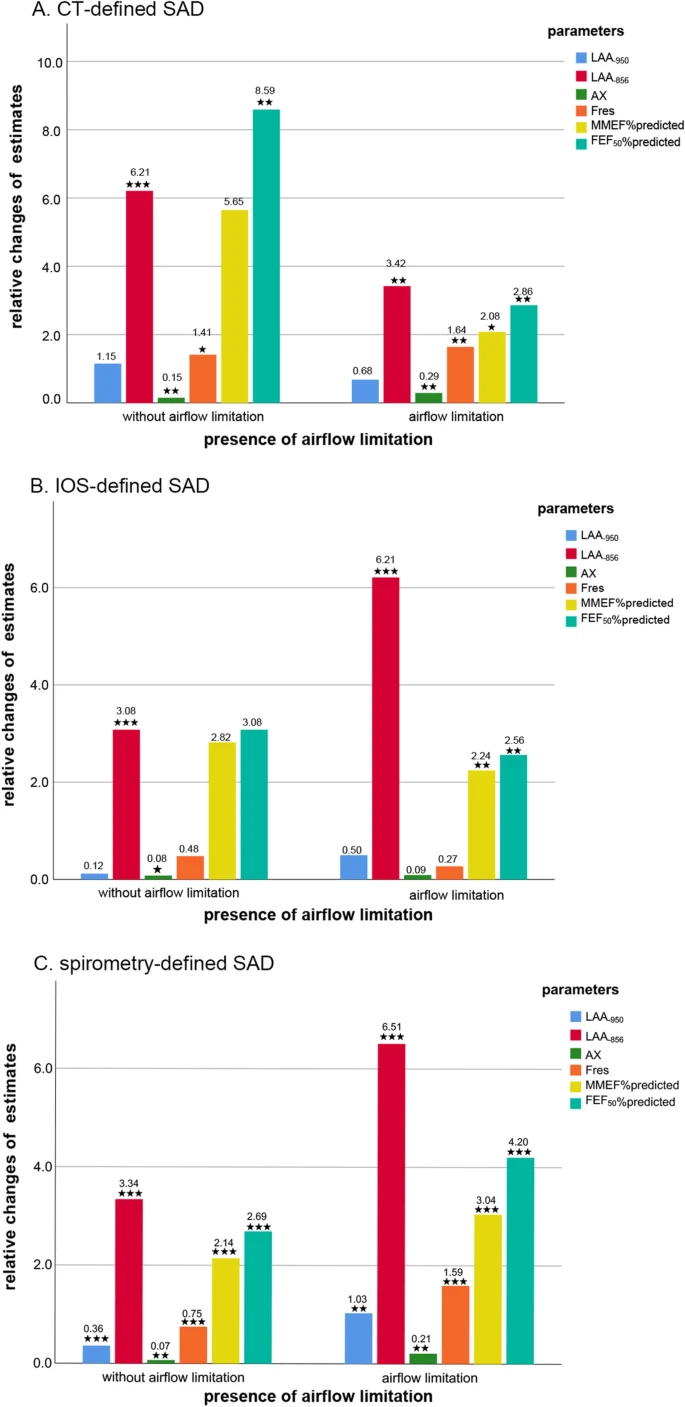Respiratory Research volume 23, Article number: 229 (2022)
Abstract
Background
Aging has been evidenced to bring about some structural and functional lung changes, especially in COPD. However, whether aging affects SAD, a possible precursor of COPD, has not been well characterized.
Objective
We aimed to comprehensively assess the relationship between aging and SAD from computed tomography, impulse oscillometry, and spirometry perspectives in Chinese.
Methods
We included 1859 participants from ECOPD, and used a linear-by-linear association test for evaluating the prevalence of SAD across various age subgroups, and multivariate regression models for determining the impact of age on the risk and severity of SAD. We then repeated the analyses in these subjects stratified by airflow limitation.
Results
 The prevalence of SAD increases over aging regardless of definitional methods. After adjustment for other confounding factors, per 10-yrs increase in age was significantly associated with the risk of CT-defined SAD (OR 2.57, 95% CI 2.13 to 3.10) and the increase in the severity of air trapping (β 2.09, 95% CI − 0.06 to 4.25 for LAA-856), airway reactance (β − 0.02, 95% CI − 0.04 to − 0.01 for X5; β 0.30, 95% CI 0.13 to 0.47 for AX; β 1.75, 95% CI 0.85 to 2.66 for Fres), as well as the decrease in expiratory flow rates (β − 3.95, 95% CI − 6.19 to − 1.71 for MMEF%predicted; β − 5.42, 95% CI − 7.88 to − 2.95 for FEF50%predicted) for SAD. All these associations were generally maintained in SAD defined by IOS or spirometry. After stratification of airflow limitation, we further found that the effect of age on LAA-856 was the most significant among almost all subgroups.
The prevalence of SAD increases over aging regardless of definitional methods. After adjustment for other confounding factors, per 10-yrs increase in age was significantly associated with the risk of CT-defined SAD (OR 2.57, 95% CI 2.13 to 3.10) and the increase in the severity of air trapping (β 2.09, 95% CI − 0.06 to 4.25 for LAA-856), airway reactance (β − 0.02, 95% CI − 0.04 to − 0.01 for X5; β 0.30, 95% CI 0.13 to 0.47 for AX; β 1.75, 95% CI 0.85 to 2.66 for Fres), as well as the decrease in expiratory flow rates (β − 3.95, 95% CI − 6.19 to − 1.71 for MMEF%predicted; β − 5.42, 95% CI − 7.88 to − 2.95 for FEF50%predicted) for SAD. All these associations were generally maintained in SAD defined by IOS or spirometry. After stratification of airflow limitation, we further found that the effect of age on LAA-856 was the most significant among almost all subgroups.Conclusions
Aging is significantly associated with the prevalence, increased risk, as well as worse severity of SAD. CT may be a more optimal measure to assess aging-related SAD. The molecular mechanisms for the role of aging in SAD need to be explored in the future.
No comments:
Post a Comment